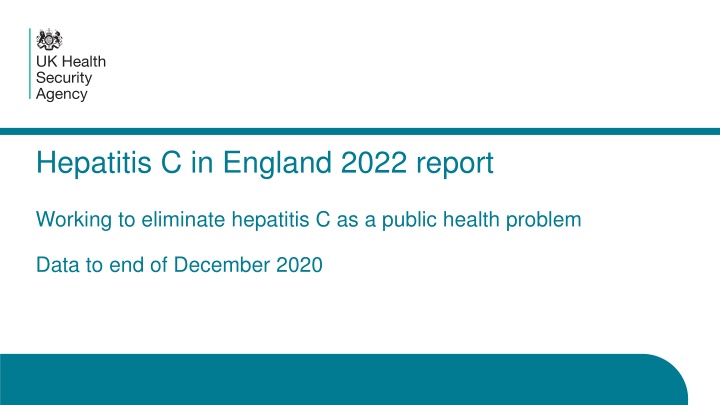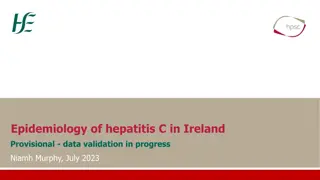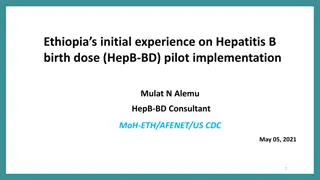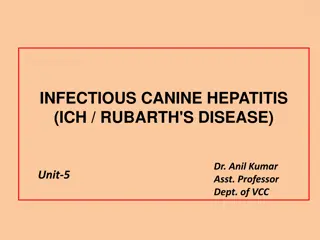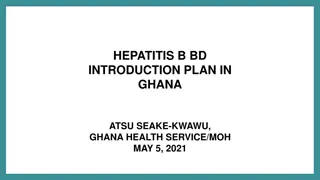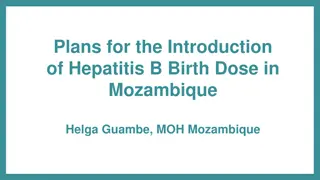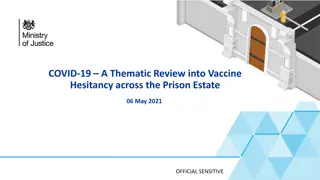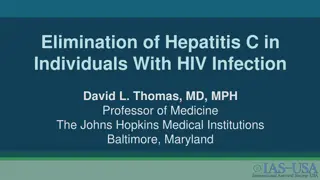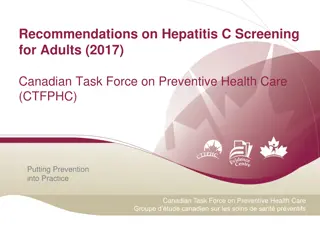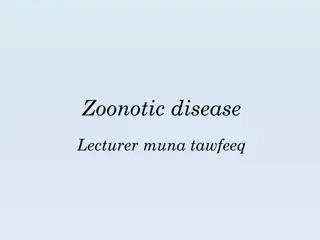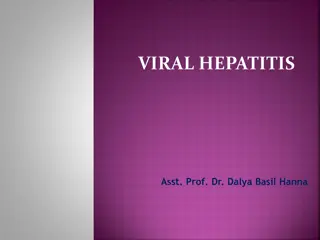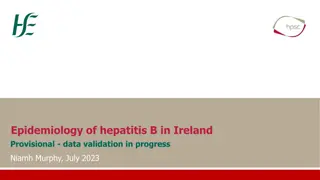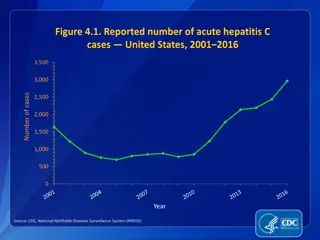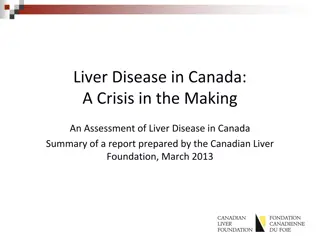Decline of Hepatitis C in England: 2022 Report Highlights
The 2022 report on Hepatitis C in England shows a continued decline in the prevalence of chronic HCV infection, with around 81,000 individuals estimated to be affected in 2020. The report also highlights the distribution of infections among individuals with different drug injecting histories. Data from the Unlinked Anonymous Monitoring Survey of People Who Inject Drugs provides insights into the prevalence of HCV among this group. Access to treatment appears to be a significant factor driving the reduction in chronic HCV infection rates. The report also presents trends in HCV prevalence among people injecting psychoactive drugs in England from 2011 to 2020. Overall, efforts are underway to eliminate Hepatitis C as a public health concern in the country.
Download Presentation

Please find below an Image/Link to download the presentation.
The content on the website is provided AS IS for your information and personal use only. It may not be sold, licensed, or shared on other websites without obtaining consent from the author.If you encounter any issues during the download, it is possible that the publisher has removed the file from their server.
You are allowed to download the files provided on this website for personal or commercial use, subject to the condition that they are used lawfully. All files are the property of their respective owners.
The content on the website is provided AS IS for your information and personal use only. It may not be sold, licensed, or shared on other websites without obtaining consent from the author.
E N D
Presentation Transcript
Hepatitis C in England 2022 report Working to eliminate hepatitis C as a public health problem Data to end of December 2020
Prevalence of HCV infection in England The estimated prevalence of chronic HCV infection in England has continued to decline to around 81,000 (95% credible interval: 66,000 to 94,000) in 2020. Of the 81,000 people living with chronic HCV, modelling suggests 27% of these infections are in people with current or recent drug injecting risk, 62% are in those with a past drug injecting history but who are no longer injecting, and 11% are in those with no history of injecting. Note: For the full context of this slidedeck, please refer to the Hepatitis C in England 2022 report.
Estimates of chronic prevalence of HCV in England, 2010 to 2020 (bars represent 95% credible intervals)(25) Data source: Modelled estimates of chronic HCV prevalence (see Appendix 3, section 1 of the full report), based on HCV prevalence data from the Unlinked Anonymous Monitoring Survey of People Who Inject Drugs (4); estimates of the number of people who inject drugs (26); Hospital Episode Statistics (HES), NHS Digital for England. Produced by UKHSA (data on severe HCV-related liver disease); Trent cohort data (estimates of disease progression probabilities) and data on HCV treatment (IMS sales data, Sentinel Surveillance of Bloodborne Virus Testing and the NHS England Hepatitis C Patient Registry and Treatment Outcome System).
Prevalence of HCV infection in people who inject drugs (PWID) Data from the UAM Survey suggests the prevalence of chronic HCV infection in PWID to be 17.3% in 2020 (23.8% in 2019; 28.7% in 2015), although 2020 data is provisional given the difference in geographical distribution of samples collected in 2020 during the COVID-19 pandemic, the change in risk profile of participants, and the smaller sample size (4). Increases in those ever infected with HCV, combined with recent decreases in chronic HCV infection, among PWID between 2015 and 2020 suggest that increased access to treatment, rather than improved harm reduction, is the main driver of the reduction in prevalence of chronic HCV infection among PWID.
Trend in HCV prevalence* among people injecting psychoactive drugs in England: 2011 to 2020 Data source: Unlinked Anonymous Monitoring Survey of people who inject drugs in contact with specialist services (4)
Incidence of HCV infection Whilst alternative ways of monitoring HCV incidence need to be considered, proxy measures based on HCV prevalence suggest some progress has been made, with modelled estimates showing a decrease in HCV prevalence of 37% among the general population, and provisional UAM data showing a relative percentage decrease of 40% among PWID, between 2015 and 2020. Preliminary estimates of reinfection following treatment using surveillance data suggest conservative reinfection rates of 8%, which are higher among those with a known history of injecting drug use (11%). Therefore, current evidence suggests more needs to be done to prevent new and reinfections.
Reducing the incidence of HCV infection (WHO impact target) Impact target area WHO GHSS 2020 target relative to 2015 baseline(3) WHO GHSS 2030 target relative to 2015 baseline(3) WHO interim guidance elimination validation target: annual absolute HCV incidence rates(2) Incidence: New cases of chronic viral hepatitis C infection 30% reduction 80% reduction 5/100,000 persons ( 2/100 for PWID) Proxy measure: alternative WHO approach, but not adequate for validation of elimination Reduction in HCV viraemia prevalence by 80% from 2015 baseline (in general population and PWID) Progress in England Proxy measure: reduction in HCV viraemia prevalence from 2015 baseline (in general population) Proxy measure: reduction in HCV viraemia prevalence from 2015 baseline (in PWID) 37.2% by 2020* (31.0% by 2019) 39.7% by 2020** (17.1% by 2019) * 2020 figures include provisional data from the UAM study, that may have been affected by COVID-19 ** 2020 figures are provisional due to the impact of COVID-19 on national bio-behavioural surveys of BBV in PWID in 2020 (UAM Survey)
HCV-related morbidity and mortality Since 2015, HCV-related mortality fell by 35% by 2020. This 35% fall has surpassed (more than 3-fold) the World Health Organization (WHO) 2020 elimination target of a 10% reduction by 2020 from the 2015 baseline. The WHO interim target to reduce HCV-related mortality to less than or equal to 2 per 100,000 persons has already been hit in England (0.56 per 100,000 population in 2020). By 2020, first hospitalisations for serious HCV-related liver disease were down 17% on levels in 2015. By 2020, registrations for a first liver transplant in patients with HCV-related disease were down 40% on levels in 2015.
Reducing HCV-related mortality (WHO impact target) Impact target area WHO GHSS 2020 target relative to 2015 baseline(3) WHO GHSS 2030 targets relative to 2015 baseline(3) WHO interim guidance elimination validation target: annual absolute HCV- related mortality rate(2) Mortality: Viral hepatitis C deaths 10% reduction 65% reduction 2/100,000 persons Progress in England Mortality: Viral hepatitis C deaths 34.9% reduction 0.56 per 100,000 population (2020)* Even if reporting of HCV on death certification has not improved beyond levels historically reported (51, 52) these preliminary figures suggest the 2030 WHO interim elimination metric has already been met.
Death registrations and annual HCV-related mortality rates in England, 2005 to 2020 Data source: Office for National Statistics (53)
Proportion of people with chronic HCV diagnosed (WHO programme target) and aware of their infection National data and surveys suggest that more than half of people who inject drugs may be unaware of their chronic HCV infection More needs to be done to improve diagnosis overall, including among people with past risk factors for infection. In partnership with stakeholders, a variety of initiatives and resources have, or are being developed to help raise awareness of HCV and increase the numbers diagnosed, including through improved case finding and testing in both the general population and among risk groups. These are summarised, with live links, in the HCV in England 2022 report.
Proportion of people with chronic HCV diagnosed (WHO programme target) and aware of their infection Service coverage/program me target area WHO EURO 2020 target(6) WHO GHSS 2030 target (3) WHO interim guidance elimination validation target (2) Proportion of people with chronic HCV diagnosed 50% [75% of estimated number of patients at late stage of viral hepatitis-related liver disease (cirrhosis or HCC) diagnosed] 90% 90% Progress in England Proxy measure: Proportion of PWID testing positive for HCV RNA in the UAM Survey who are aware of their chronic HCV infection 40.4% in 2020 (33.9% in 2019)
Estimated proportion of people injecting psychoactive drugs testing positive for HCV who are aware of their infection, England, 2010 to 2020 (bars are 95% CI) Data source: Unlinked Anonymous Monitoring Survey of people who inject drugs: people injecting psychoactive drugs (4)
Prevention of infection Harm reduction among people who inject drugs remains sub-optimal, with reductions in the prevalence of chronic HCV infection primarily the result of increased HCV treatment. Harm reduction among people who inject drugs needs to be scaled up to prevent both primary infection and reinfection following HCV treatment if elimination is to be achieved and sustained.
Prevention of infection by ensuring adequate harm reduction in PWID (WHO programme targets) Service coverage/ programme target area WHO GHSS 2030 target(3) WHO interim guidance elimination validation target (2) At least 300 sterile needles and syringes provided per person who injects drugs per year WHO EURO 2020 targets (6) Harm reduction: A comprehensive package of harm reduction services to all PWID(72) including: At least 300 sterile needles and syringes provided per person who injects drugs per year At least 200 sterile needles and syringes provided per person who injects drugs per year At least 40% of opioid dependent PWID receive OST 90% of PWID receiving targeted HCV information, education and communication Progress in England Harm reduction: A comprehensive package of harm reduction services to all PWID(72) including: Among people injecting psychoactive drugs participating in the UAM Survey during 2020, 62.7% reported adequate NSP for their needs (66.1% in 2019) 55.5% of opioid dependent PWID receive OST (tax year 2011 to 2012*) 75.8% of UAM Survey participants in 2020 (79.9% in 2019), who had injected drugs in the last year, reported receiving some form of information that explained what HCV is, how they could avoid catching it, or how it is treated, in the last year.
Estimated proportion of people injecting psychoactive drugs reporting adequate* needle and syringe provision in England, 2011 to 2020 (bars are 95% CI) Data source: Unlinked Anonymous Monitoring Survey of people who inject drugs: people injecting psychoactive drugs (4)
Uptake of HCV testing Whilst much progress has been made to increase the numbers accessing HCV testing, particularly through NHS England funded elimination initiatives, testing has been impacted by the COVID-19 pandemic and has only partially recovered. If elimination targets are to be met, a redoubling of effort is required to ensure that everyone at risk of HCV infection can access testing. It will be critical to expand our reach to underserved groups, particularly as numbers with HCV infection fall, and to implement and evaluate approaches that facilitate testing (and treatment) of those groups who are at greatest risk of falling out of the care pathway.
Information on HCV testing in various settings is available in the HCV in England 2022 report Data on HCV testing is available for: primary care and the wider population people who inject drugs and/or attend drug and alcohol services people in secure and detained settings those who have experienced homelessness South Asian and other minority ethnic populations people attending sexual health and HIV services the blood donor (lower risk) population Some examples of these follow:
Number of laboratory reports* of HCV from England: 2010 to 2020** Data source: SGSS (36)
Number of individuals tested for anti-HCV by year, and proportion positive, through GP surgeries in 19 sentinel laboratories: 2015 to 2020* Data source: Sentinel Surveillance of Bloodborne Virus Testing (32)
Trends in self-reported uptake of testing for HCV infection among PWID in England: 2009 to 2020 Data source: Unlinked Anonymous Monitoring Survey of People Who Inject Drugs: people injecting psychoactive drugs (4)
Proportion of new receptions to secure and detained settings tested for HCV: from tax year 2010 to 2011 up to tax year 2020 to 2021* Data source: Prison Health Performance Quality Indicators (PHPQIs, NHS Trust Development Agency: palest blue Bars), Health and Justice Indicators of performance (HJIPs, dark teal bars), and the Health and Justice Strategic Reporting Unit s Health and Justice Information System data (H&J SRU, light teal bars).
Trend in HCV prevalence* among PWID reporting homelessness in the last year in England: 2011 to 2020 Data source: Unlinked Anonymous Monitoring Survey of people who inject drugs in contact with specialist services (4)
Number of individuals tested for anti-HCV by year, and proportion positive, in people of South Asian^ origin in 19 sentinel laboratories: 2015 to 2020* Data source: Sentinel Surveillance of Bloodborne Virus Testing (32)
Proportion of people accessing HIV care who have HCV by demographic group,* England, 2020 , Data Source: HARS (90)
Rate of HCV among donations from new and repeat blood donors in England: September 1991 to 2020* Data source: NHSBT UKHSA Epidemiology Unit
Monitoring access to HCV treatment (WHO programme target) Substantial progress has been made to increase the numbers accessing HCV treatment, with around 58,850 treatment initiations between tax years 2015 to 2016 and 2020 to 2021. Further work is required to reach the 2030 WHO target of at least 80% of people with chronic HCV diagnosed, accessing treatment (65% in 2015 to 2020). Among those who started treatment and were not lost to follow-up, rates of viral clearance are high at 95%.
Monitoring access to HCV treatment (WHO programme target) Service coverage/progra mme target area WHO EURO 2020 targets (6) WHO GHSS 2030 target(3) WHO interim guidance elimination validation target (2) Treatment coverage of people diagnosed with chronic HCV [90% of diagnosed patients with chronic HCV are linked to care and adequately monitored] 75% (>90% cured) 80% 80% Progress in England Treatment coverage of people diagnosed with chronic HCV (2015-2020) [73.5%* of diagnosed patients with chronic HCV are linked to specialist HCV treatment services] 65.3%** of those with diagnosed chronic HCV initiating treatment (78.6% SVR of those with treatment outcome reported)*** 65.3%**
Treatment pathway for individuals with a positive RNA or antigen test in SSBBV between 2015 and 2020* Data source: Sentinel Surveillance of Bloodborne Virus Testing (32) and NHS England data from the Hepatitis C Patient Registry and Treatment Outcome System as of 19 October 2021.
Provisional estimates of numbers initiating HCV treatment in England, 2007 to tax year 2020 to 2021 Data Source: (i) NHS England for data from the hepatitis C patient registry and treatment outcome system as of 23 June 2021 and for DAA drug commissioning data for tax years 2015 to 2016 and 2020 to 2021 (commissioning data is based on clinician intention to treat and invoicing and is subject to data quality issues and contract adjustments); (ii) Sentinel surveillance of hepatitis bloodborne virus testing for scaled estimates for the period 2012 to 2014; (iii) Estimates from Roche sales, IMS supply chain manager, and Pharmex data for 2007 to 2011 (28).
Addressing inequalities There is an urgent need, particularly following the COVID-19 pandemic, to redouble efforts to improve harm reduction, testing and access to treatment for the most vulnerable populations or inequalities will widen. As we approach elimination it will be increasingly important to take a person-centred approach.
WHO GHSS targets (3) for viral hepatitis, relevant to HCV in the UK context, with 2020 targets updated to reflect the action plan for the health sector response to viral hepatitis in the WHO European Region (6) and proposed interim targets from the WHO interim guidance for country validation of hepatitis elimination (2) Impact target area WHO GHSS 2020 target relative to 2015 baseline (3) WHO GHSS 2030 target relative to 2015 baseline (3) 80% reduction WHO interim guidance elimination validation target: annual absolute HCV incidence rates (2) Incidence: New cases of chronic viral hepatitis C infection 30% reduction Equal to or less than 5 per 100,000 persons (equal to or less than 2 per 100 for PWID) [Reduction in HCV viraemia prevalence by 80% from 2015 baseline (in general population and PWID)] [Proxy incidence measure: alternative WHO approach, but not adequate for validation of elimination] Mortality: Viral hepatitis C deaths 10% reduction 65% reduction Equal to or less than 2 per 100,000 persons WHO interim guidance elimination validation target (2) 100% Service coverage or programme target area Blood safety:* Proportion of donations screened in a quality- assured manner Percentage of injections administered with safety engineered devices in and out of health facilities** WHO EURO 2020 target (6) 100% WHO GHSS 2030 target (3) 100% 50% 90% 0% Unsafe injections:** * In England, 2020 and 2030 targets are already met (104) ** In England, 2020 and 2030 targets are already met in the health care setting as the UK follows the EU Directive for the prevention of sharps injuries in the health care setting (105) by using safety engineered devices
WHO GHSS targets(3) for viral hepatitis, relevant to HCV in the UK context, with 2020 targets updated to reflect the action plan for the health sector response to viral hepatitis in the WHO European Region (6) and proposed interim targets from the WHO interim guidance for country validation of hepatitis elimination (2) Service coverage or programme target area WHO EURO 2020 target (6) WHO GHSS 2030 target (3) WHO interim guidance elimination validation target (2) Proportion of people with chronic HCV diagnosed 50% Greater than or equal to 90% Greater than or equal to 90% [75% of estimated number of patients at late stage of viral hepatitis-related liver disease (cirrhosis or HCC) diagnosed] Harm reduction: A comprehensive package of harm reduction services to all PWID (72) including: At least 200 sterile needles and syringes provided per person who injects drugs per year At least 300 sterile needles and syringes provided per person who injects drugs per year At least 300 sterile needles and syringes provided per person who injects drugs per year At least 40% of opioid dependent PWID receive OST 90% of PWID receiving targeted HCV information, education and communication Treatment coverage of people diagnosed with chronic HCV [90% of diagnosed patients with chronic HCV are linked to care and adequately monitored] Greater than or equal to 80% Greater than or equal to 80% 75% (more than 90% cured)
References 1. UK Health Security Agency (UKHSA). 'HCV in England report 2022 Headline Data Table' 2022 (viewed on 7 February 2022) 2. World Health Organization (WHO). 'Interim guidance for country validation of viral hepatitis elimination' 2021 (viewed on 7 February 2022) 3. WHO. 'Global health sector strategy on viral hepatitis, 2016 to 2021: towards ending viral hepatitis' 2016 (viewed on 7 February 2022) 4. Public Health England (PHE). Unlinked Anonymous Monitoring Survey of PWID in contact with Specialist Drug Services' 2020 (viewed on 7 February 2022) 6. WHO. 'Action plan for the health sector response to viral hepatitis in the WHO European Region (2017)' (viewed on 7 February 2022) 23. Harris RJ and others. 'New treatments for hepatitis C virus (HCV): scope for preventing liver disease and HCV transmission in England' Journal of Viral Hepatitis 2016: volumen 23, issue 8, pages 631-643 24. PHE. 'Impact of COVID-19 on STIs, HIV and viral hepatitis in England: 2020 report (provisional data)' (viewed on 7 February 2022) 25. PHE. 'HCV in the UK 2020' (viewed on 7 February 2022) 26. Hay G, and others. 'Estimates of the prevalence of opiate use and/or crack cocaine use 2011 to 2012: Sweep 8 report' 2014 (viewed on 7 February 2022) 28. Harris RJ and others. 'Increased uptake and new therapies are needed to advert rising hepatitis C- related end stage liver disease in England: modelling the predicated impact of treatment under different scenarios' Journal of Hepatology 2014: volume 61, issue 3, pages 530-537 32. PHE. 'Sentinel surveillance of blood borne virus testing in England: 2020' (viewed on 7 February 2022) 34. Hay G and others. 'National and regional estimates of the prevalence of opiate use and/or crack cocaine use 2005/06: a summary of key findings Research Development and Statistics Directorate, Home Office Home Office 2007 (viewed on 7 February 2022) 36. PHE. 'Laboratory reports of hepatitis C in England and Wales, April to June 2020. Health Protection Report' 2021 (viewed on 7 February 2022) 44. National Institute for Health and Care Excellence (NICE). 'Ombitasvir paritaprevir ritonavir with or without dasabuvir for treating chronic hepatitis C. NICE technology appraisal guidance [TA365]' 2015 (viewed on 7 February 2022) 45. NICE. 'Daclatasvir for treating chronic hepatitis C' 2015 (viewed on 7 February 2022) 46. NNICE. 'Ledipasvir sofosbuvir for treating chronic hepatitis C' 2015 (viewed on 7 February 2022) 47. NICE. 'Sofosbuvir velpatasvir for treating chronic hepatitis C' 2017 (viewed on 7 February 2022)
References 48. NICE. 'Elbasvir grazoprevir for treating chronic hepatitis C' 2016 (viewed on 7 February 2022) 49. NICE. 'Glecaprevir pibrentasvir for treating chronic hepatitis C. Technology appraisal guidance [TA499]' 2018 (viewed on 7 February 2022) 50. NICE. 'Sofosbuvir velpatasvir voxilaprevir for treating chronic hepatitis C. Technology appraisal guidance [TA507]' 2018 (viewed on 7 February 2022) 51. PHE. 'Hepatitis C in the UK 2017 report' (viewed on 7 February 2022) 52. Mann AG and others. 'Diagnoses of, and deaths from, severe liver disease due to hepatitis C in England between 2000 and 2005 estimated using multiple data sources' Epidemiology and Infection 2013: volume 137, issue 4, pages 513-518 53. Office for National Statistics. 'Deaths broken down by age, sex, area and cause of death' 2020 (viewed on 7 February 2022) 59. PHE. 'Evaluation of hepatitis C test and treat interventions targeted at homeless populations (outside London) in England during the COVID-19 pandemic 2020 report' 2021 (viewed on 7 February 2022) 72. WHO. 'WHO, UNODC, UNAIDS technical guide for countries to set targets for universal access to HIV prevention, treatment and care for injecting drug users 2012 revision' 2013 (viewed on 7 February 2022) 77. NHS England. 'National Partnership Agreement between: The National Offender Management Service, NHS England and Public Health England for the Co- Commissioning and Delivery of Healthcare Services in Prisons in England 2015-2016' 2014 (viewed on 7 February 2022) 80. Cummins C and others. 'An assessment of the Nam Pehchan computer program for the identification of names of south Asian ethnic origin' Journal of Public Health Medicine 1999: volume 21, issue 4, pages 401-406 81. ONOMAP. ONOMAP 2012 (viewed on 7 February 2022) 90. PHE. 'HIV surveillance systems' 2008 ( viewed on 7 February 2022) 98. PHE. 'Hepatitis C treatment monitoring in England (data to end April 2018)' 2018 (viewed on 7 February 2022) 104. Joint United Kingdom (UK) Blood Transfusion and Tissue Transplantation Services Professional Advisory Committee 'Guidelines for the Blood Transfusion Services in the UK' 2022 (viewed on 7 February 2022) 105. European Agency for Safety and Health at Work. 'Directive 2010/32/EU - prevention from sharp injuries in the hospital and healthcare sector' 2010 (viewed on 7 February 2022)
